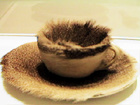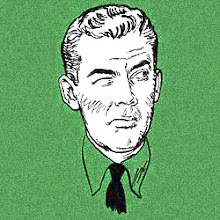 Summer '60: a Hollywood version of Kerouac's The Subterraneans is released, starring George Peppard. Philip Sheuer's review in the Los Angeles Times was given the headline, "Sensitive Film Tale Views Gropings of Beatniks" and indeed the photo designed into the story shows Peppard grabbing Leslie Caron hard from behind. "Even MGM is worried. Apparently fearful that the people, or squares, who might otherwise be attracted to the theaters, won't go." The studio used this phrase in its PR: "Today's Strange Young Rebels." Then Scheuer: "I'm not sure that I savvy what all the whoop-te-do is about."
Summer '60: a Hollywood version of Kerouac's The Subterraneans is released, starring George Peppard. Philip Sheuer's review in the Los Angeles Times was given the headline, "Sensitive Film Tale Views Gropings of Beatniks" and indeed the photo designed into the story shows Peppard grabbing Leslie Caron hard from behind. "Even MGM is worried. Apparently fearful that the people, or squares, who might otherwise be attracted to the theaters, won't go." The studio used this phrase in its PR: "Today's Strange Young Rebels." Then Scheuer: "I'm not sure that I savvy what all the whoop-te-do is about."The PR tagline in full: "These are The Subterraneans. Today's Young Rebels - who live and love in the world of their own. This is their story told to the hote rhythms of fabulous jazz."
Roddy McDowall (later an ape) makes an appearance as a poet-saint who can sleep standing up. And Arte Johnson (later of Laugh In) plays Arial Lavalerra, "a beat but not beaten Oscar Wilde--San Francisco style."
A. H. Weiler in the New York Times focuses on the sexual problems associated with this kind of writing. "Our hero finds he can't create his kind of iridescent prose with her [the Leslie Caron character] in close proximity."
Gerry Mulligan, the great jazzman, plays a sax-playing preacher. Andre Previn plays himself. Ranald MacDougall directed. The release date was June 23.

 Is '60 the moment when the end of the end of the Old Left had been reached and the New Left began to emerge? Is it the final ascendancy, in certain scenes at least, of poetic postmodernity? Surely the publication of Donald Allen's The New American Poetry that year suggests this, but then again--once again--we look back on "New" here and see continuity. The rhetoric of the Kennedy-Nixon contest made much less of a dent than everyone (at the time as well as since) claimed, so one wonders why were such great claims made?
Is '60 the moment when the end of the end of the Old Left had been reached and the New Left began to emerge? Is it the final ascendancy, in certain scenes at least, of poetic postmodernity? Surely the publication of Donald Allen's The New American Poetry that year suggests this, but then again--once again--we look back on "New" here and see continuity. The rhetoric of the Kennedy-Nixon contest made much less of a dent than everyone (at the time as well as since) claimed, so one wonders why were such great claims made?  Had we come to expect "1960" to be truly ubiquitously modern in a way that the 1950s really were not--not quite? And what specifically does "modern" mean in the Kennedyesque talk then and now about the torch being passed to a new generation, etc.? The First Lady really meant "modernist" when Camelotians said "modern." What about the others across the new young cultural leadership? I've been surprised by how frequently the
Had we come to expect "1960" to be truly ubiquitously modern in a way that the 1950s really were not--not quite? And what specifically does "modern" mean in the Kennedyesque talk then and now about the torch being passed to a new generation, etc.? The First Lady really meant "modernist" when Camelotians said "modern." What about the others across the new young cultural leadership? I've been surprised by how frequently the  "Beat movement" was covered in 1960 in the mainstream press. I was expecting a fair measure but I've found tonnage. 1960 was the year when the figure of the beat was beginning to find acceptance, although still 80% of these stories are mocking, rebels-without-cause condescension. For anyone whose analysis made an impact nationally, do these antipolitical adolescents count as part of the "new young cultural leadership"? No, but rather than the two being opposites, they fall along a Continuum of the New American. Now that's a change for '60.
"Beat movement" was covered in 1960 in the mainstream press. I was expecting a fair measure but I've found tonnage. 1960 was the year when the figure of the beat was beginning to find acceptance, although still 80% of these stories are mocking, rebels-without-cause condescension. For anyone whose analysis made an impact nationally, do these antipolitical adolescents count as part of the "new young cultural leadership"? No, but rather than the two being opposites, they fall along a Continuum of the New American. Now that's a change for '60.







